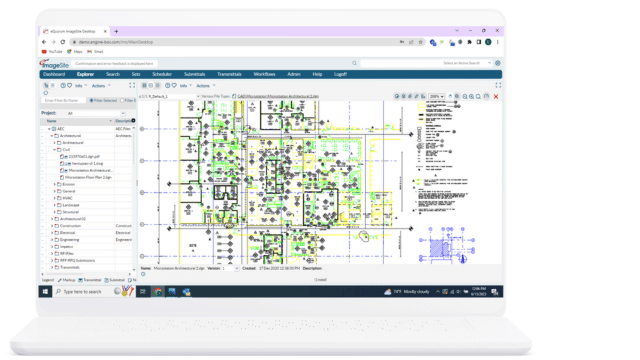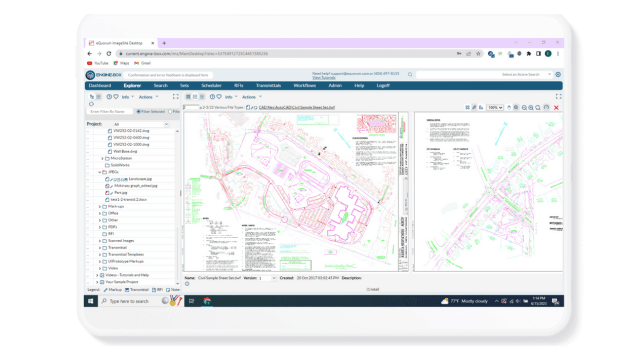How To Improve Each Phase of the Construction Lifecycle
How To Improve Each Phase of the Construction Lifecycle
The commercial construction lifecycle typically consists of five phases. To carry out these types of projects, organizations must complete each phase carefully, yet efficiently with the best interest of the owners and other stakeholders. While the complexities of these projects often go unseen by the general public, construction projects are organized efforts, managed by a variety of workers with a vast range of specialties. Throughout these efforts, architects, engineers, and construction workers collaborate over thousands of drawings and documents throughout these five phases to ensure deliverables are met.
The 5 phases of commercial construction lifecycle are:
Phase 1: The Initiation Phase
The initiation phase is where ideas are translated into actionable items using input from project teams. During this phase, the project manager and project team work together to evaluate the feasibility of a project, which is typically achieved by defining the project and determining possible solutions that fit the specific needs of the development. It’s important to recognize that these solutions should not be determined single-handedly but should stem from a culmination of ideas and suggestions between multi-disciplinary experts.

Using Automation To Manage Construction Workflows
AEC organizations can utilize automation to improve existing processes and ensure the accuracy and timeliness of a project. While large companies were among the first to explore automation, SMBs can use workflow automation to gain a competitive edge over their competitors, and complete projects within a shorter timeframe and ensuring nothing falls through the cracks.
Note: There are five basic design stages that architects, in particular, must follow when assessing the viability of a project, including schematic design (SD), design development (DD), construction documents (CD), construction administration (CA), and construction support services (CSS). These stages occur throughout the construction lifecycle and require a large number of documents to be retained and approved. Construction companies can use a document management system to keep files and documents secured and organized with associated audit trails, as these systems host capabilities for document versioning and workflow management.
Phase 2: The Planning Phase
As the old saying goes, “Measure twice. Cut once.”
Once the team has performed a feasibility test, they commence Phase 2 of the construction lifecycle – the planning phase. Careful planning is essential to the success of a construction project, as several issues can arise from simple mistakes. The planning stage is considered critical to the construction lifecycle, as it’s where the team defines tasks and identifies the scope of the project. Budgeting and approvals also take place during this stage, and the team ultimately decides whether the project is worth pursuing.
Automating the Engineering Change Management Process
1:25 min
Changes required during later phases of the design process greatly impact project costs and schedules. AECs need a rigorous engineering change management process to keep projects on track.
Phase 3: The Execution Phase
The execution phase is where the project comes to life. Communication is vital throughout implementation, since its where all the parts come together. Workers are assigned tasks, resources are allocated, and meetings are put in place to assess the status of the project. While the majority of the planning is completed in the prior stage, teams will often need to adjust deadlines to meet the real-world requirements of the project. Changes often come fast, and in bundles, and this is where a formal, disciplined approach to maintaining and distributing important drawings and documents is really helpful.
Phase 4: The Performance Monitoring Phase
Unlike the other phases, the performance monitoring stage occurs simultaneously with the implementation stage of the construction lifecycle. Regularly monitoring performance ensures each item is implemented effectively, so adjustments can be made as needed. Cost tracking, quality, and completion toward objectives are some key performance indicators that project managers can track to determine whether the project is meeting requirements.
Phase 5: The Closing Phase
The closing phase, sometimes known as the completion phase, is the part of the project in which project managers are prepared to offer deliverables to their clients. During this stage, final inspections are made, and the project is approved by either the client or owner. Once the project is completed, and the client has determined there are no more changes to be made, the project is closed out.
WATCH VIDEO
Intelligent Construction Opportunities welcomes Scott Brandt President and CEO of eQuorum to discuss specifics around what construction engineers need to consider when using document control systems.
Additional EDMS Features
Our EDMS solutions
ImageSite and EngineBox are eQuorum’s robust workflow and document management solutions, created to help workers manage their essential workflows while maintaining complete control over their engineering files and documents. Not only do they provide a secure collaboration site for workers, but they also help organizations manage document distribution with third parties like vendors, contractors, and customers. Both systems are offered at a competitive price, enabling organizations to get a quick return on their investment by providing the features and functionality needed to help organizations improve efficiency, productivity, and collaboration. Companies can choose from concurrent user subscriptions or named user subscriptions, ensuring organizations have subscription options that make sense for their business.

ImageSite®
Our single source engineering workflow and document management system. Built in HTML5 so there is no software to deploy to client computers or mobile apps to download. Offered as an On-premise or Private Cloud system.
EngineBox™
EngineBox is a cloud based workflow and document management version of ImageSite that resides outside the corporate network.
Our EDMS solutions
ImageSite and EngineBox are eQuorum’s robust workflow and document management solutions, created to help workers manage their essential workflows while maintaining complete control over their engineering files and documents. Not only do they provide a secure collaboration site for workers, but they also help organizations manage document distribution with third parties like vendors, contractors, and customers. Both systems are offered at a competitive price, enabling organizations to get a quick return on their investment by providing the features and functionality needed to help organizations improve efficiency, productivity, and collaboration. Companies can choose from concurrent user subscriptions or named user subscriptions, ensuring organizations have subscription options that make sense for their business.

EngineBox™
EngineBox is a cloud based workflow and document management version of ImageSite that resides outside the corporate network.
The eQuorum Customer Promise
In 2005, eQuorum developed the first all browser-based EDMS. The system, although for on-premise use, was still created to remove client software and JAVA from user computers and allow users to have a single viewer based on the simple navigation functionality of browsers. Today, eQuorum provides that same application in a private Cloud or a SaaS Cloud option. We can do this because we are, and have always been, browser-based, understanding the enhanced speed, security, and usability of this technology.
With the abundance of document management systems on the market today, there’s no doubt that choosing the right Cloud document management software can be a difficult decision. eQuorum is here to provide a comprehensive, powerful, and most importantly – affordable Cloud document management solution. We believe in providing real value to our customers by eliminating unnecessary costs, providing industry-leading functionality, and equipping your team with the right tools using cutting edge technology to bring your products to market faster.
eQuorum®
We specialize in engineering workflow and document management. Our comprehensive, yet easy-to-use software provides the solution to manage data from design to manufacturing and production, to sales, support and administration.
